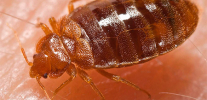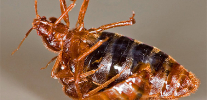
Bed bugs are among the most well known insects with incomplete transformation. This means that in their development each individual of bugs does not go through such complex transformations as are characteristic of butterflies or beetles. The larvae of bugs externally are miniature copies of adult insects, although some features of their structure, in addition to body size, still clearly demonstrate their juvenile nature.
Inexperienced resident of a large city, often not knowing how the bug larva lookscan easily confuse a young insect with other guests of the dwelling: ants, small cockroaches, lice. But at the same time, the presence of bed parasite larvae in a house, hotel or cottage means that there is a whole population of insects that will ruin their lives and prevent them from sleeping. Therefore, knowing what they look like is worth it, at least in order to start taking measures to protect your home from uninvited guests when you first meet them in time.
The appearance of larvae of domestic bugs
Larvae of domestic bugs are similar in appearance to adult individuals and have a body that is flattened from above. The length of their body varies from 0.5 to 2 millimeters, and the color varies from light yellow, almost white (in the youngest) to usual brown, typical of adult insects (in the larvae before the last molt).
In entomology, it is accepted to call the larvae such age forms of insects that are significantly different from adults. For example, the larvae of butterflies or flies are the so-called typical ones. Such insects belong to the group of insects with full transformation. In addition to flies, mosquitoes and butterflies, they include beetles, equestrians, ants and bees, and some other groups.
Bugs belong to the group of insects with incomplete transformation. In them, the larva emerging from eggs has a body structure similar to that of an adult insect, differing only in certain details and inability to reproduce. Such a larva is called a nymph.
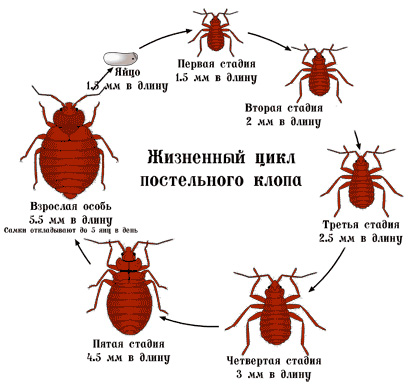
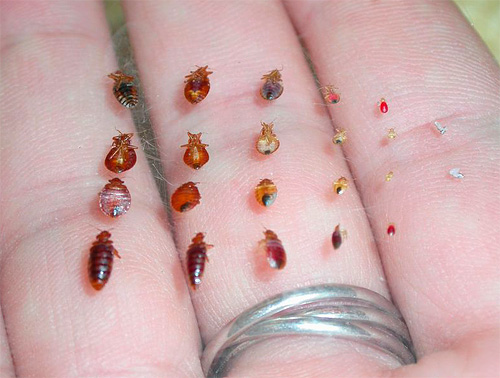
As it develops, it grows out of its hard shell and therefore has to constantly shed. The nymph molts 5 times, turning into an adult insect after the last molt.The development of an insect from the release of an egg to its transformation into an imago lasts from 4 to 6 weeks, depending on the temperature in the room. The higher the temperature, the faster the whole cycle.
Bed bugs larvae have a more elongated body than in adult insects. Outwardly, they are easily confused with a cockroach nymph. For the larvae of the first age is characterized by the absence of a dark color of the abdomen (back of the calf), while the nymphs of later ages have a common light red color of the head, legs and rims of the body, and a dark middle of the abdomen. However, the saturation of the color of this dark part of their calf depends primarily on the time elapsed since the last feeding: the hungry larva has all the belly bright. In the photo with the flash in the bed bug larvae, the stomach filled with blood and the organs adjacent to it are clearly visible.
Differences of bug larvae from other arthropods
A person who is inexperienced in entomology can confuse a bed bug bug with some other unwanted guests at home.
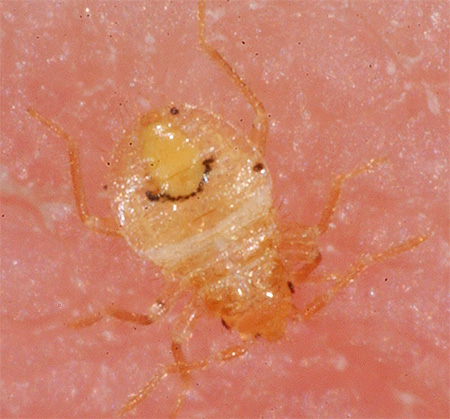
But looking carefully, or comparing the larva bedbug with photo other arthropods, you can reliably identify its species by certain characteristics:
- from the nymphs of cockroaches, the larvae of bugs are distinguished by a lighter coloring and lower mobility.In addition, the nymphs most common in the apartments of red cockroaches have a well-defined bright spot on the cephalothorax. The bug larvae do not have such a pattern;
- older larvae of bugs differ from adult cockroaches in small sizes (no more than 2 mm, while the adult red cockroach reaches a length of 10-15 mm) and the absence of wings;
- it is easy to distinguish the larvae of bedbugs from house ants by the shape of their body: upon careful examination, the absence of a “waist” between the belly and the cephalothorax and, in general, a wider body becomes immediately noticeable;
- from ticks, only occasionally brought into the house, the bed bug bug larva differs in the number of paws: it has six, and the tick has eight;
- only the smallest bed bug bugs can be confused with fleas. But if the flea is hardly perceptible because of its jumping ability, then the nymphs of the bugs are very slow. In addition, fleas are colored dark brown, and bed bugs larvae of an appropriate size are almost transparent.
The universal distinction of larvae of domestic bugs is their preferred habitat. If cockroaches live mainly near food stocks, ants - behind baseboards and under floor coverings, fleas - on domestic animals' hair, then nymphs of bugs prefer completely different places.In this they differ from lice: the latter are kept only on the hairy parts of the body, while bugs avoid them.
Food and typical habitats of bedbug larvae
Due to the low speed of movement, the bug larvae cannot move far from their main power sources. Therefore, in the largest quantities they are found where people are resting: under the mattresses, inside them, in the folds of the bed or upholstery, in close proximity to the beds on the floor and under the baseboards. It is important that in places where adult insects hide, their larvae occur together with them: no hostility is shown by adults to them.
By the way, having once discovered the place of the accumulation of parasites, the difference between adult insects and larvae is very easy to understand, not even knowing what the larvae of bedbugs or eggs look like. In places of such accumulations, large numbers of white eggs, black excrement, and chitinous membranes remaining after the molting of insects usually come across.
Larvae house bugs they feed, like adult insects, with human blood. It is believed that small nymphs leave much less painful points from bites on the body than adult insects. But they are also able to spoil the dream and give a lot of unpleasant sensations.
Where to find bedbug larvae and how to deal with them?
Measures to combat the larvae of bed bugs are no different from those for adults.
Before you start a fight, you need to find out whether bugs are the cause of bites appearing on the body. Let's look at the characteristic signs of bedbug bites:
- a large number of them after every night. Not only are bedbugs usually present in large numbers in the room, each of them makes several bites in different places during one feeding;
- distinctly noticeable “routes” of movement of each feeding larva. Usually such a move looks like a small line of 4-5 bites;
- itching in the places of the bites themselves, their redness.
Immediately at the time of feeding, the nymph of the bug is difficult to notice: it feeds at night, usually in the early morning time, which coincides with the phase of the most sound sleep of a person. If at the moment of the bite there is an itch and pain, it means that the larva bites: they do not have enough secretion in the saliva to ensure the bite is anesthetized. After adult bug bite itching begins to be felt after a few hours.
Nymphs of bedbugs are even less than adults, resistant to extreme temperatures. Freezing an apartment, house or cottage in the winter in northern areas for 2-3 days with a temperature of about -20 ° C ensures the death of almost all the larvae of bedbugs indoors. Dry heat treatment of the room gives the result in any room, however, some individuals in this case can be preserved inside the mattresses or on clothes.
Various chemical insecticides are very effective means of controlling bedbugs: dichlorvos, karbofos, various pyrethroids. However, they are toxic not only for insects, but also for people, and when they treat the premises, it is necessary to observe all precautions and, if possible, for several days, during which the treatment lasts, not to be indoors.
It is important to understand that all chemical means of protection against insect parasites are designed primarily for their destruction. Bedbugs are very difficult to scare off with different smells, and if they are hungry, it is completely impossible. Therefore, the use of most popular means of scaring bed bugs usually gives only a short-term result.
After the use of insecticides and the death of the bugs in a few days, the emergence of a new population of larvae of the youngest age is possible. They are derived from eggs laid before disinsection, and the fight against them requires a repetition of the procedure.
In the photo below you can see eggs and bed bug larvae:
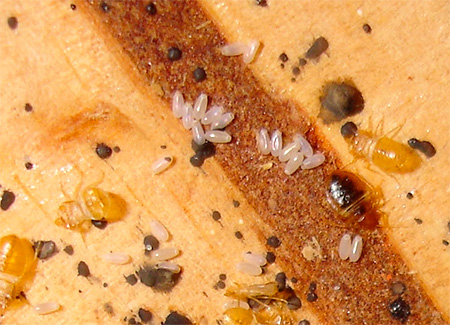
However, after such a re-disinfestation, the likelihood of the reappearance of bedbugs in an apartment depends only on the infection of their neighbors' apartments. In apartment buildings, it is most useful to conduct a coordinated mass disinsection of several (ideally all) apartments simultaneously.
In order to protect your home from the penetration of bedbugs into it, it is necessary first of all not to visit places where these parasites can be: cheap hotels, houses where hygiene is not maintained. You should not invite people to visit you whose home you are knowingly bugs live. One or two individuals, once on their clothes, will easily move to a new home and give rise to a new population. Additionally, you should regularly carry out wet cleaning in the house, check the condition of beds and sofas, wash and shake the bed.
You can keep birch brooms and bouquets of dry tansy in the house, which, to a certain extent, discourage bugs and can prevent them from moving from their neighbors.
The release of the bug larvae from the egg
How can you reliably get rid of bedbugs, including their larvae and eggs

